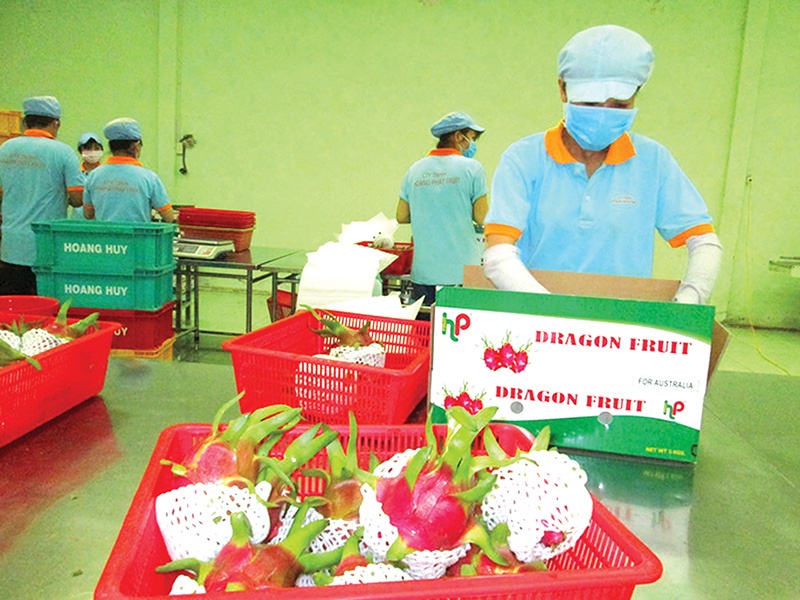Agri-exporters buckle up for unpredictable season
 |
| Agricultural exports are faced with multiple issues hindering transport. Photo: Le Toan |
“Goods exported to the US are now stuck at ports for another three weeks, in addition to the transport of more than three weeks,” said Nguyen Dinh Tung, director of Vina T&T. “Because of the pandemic, only half of the customs personnel of most countries are operating.”
T&T, which accounts for about half of Vietnam’s fresh fruit exports to the US, is under pressure as their goods are stuck at ports, which adversely affects the quality of agricultural products. Tung said container freight to US ports is seven times more costly than in the same period last year.
In October, many shipping lines had cut back trips to Vietnam, pushing up the rate of cancellation of orders to Europe and the US. Intimex JSC, one of the five largest rice exporters in Vietnam, has booked many shipping lines that have continuously been cancelled. Many other rice exporters are in the same situation. Some businesses do not dare to sign contracts with foreign partners for fear of not being able to deliver their goods.
Cancellations and a lack of empty containers also affect the imports and exports of seafood. Nguyen Hoai Nam, deputy general secretary of the Vietnam Association of Seafood Exporters and Producers (VASEP), said that businesses have to “pay extra storage costs for congested shipments at seaports.”
The fact many shipments cost up to $20,000 per container has pushed product prices to a higher level.
For a year, VASEP has received notices from a number of container shipping lines about increasing surcharges for containers from Vietnam to export markets, including to Asia.
In addition to increased surcharges, some shipping lines also announced an increase in the peak season surcharge of about $150-450 per container.
Vietnam, like many other countries, is adjusting its value chains to suit the situation. Dr. Dang Kim Son, former director of the Institute of Policy and Strategy for Agriculture and Rural Development, said that all countries avoid depending on one market or source for raw materials.
Most countries are expanding their domestic markets, even those with very deep value chains like China seek to strengthen their own markets. At the same time, they are also more proactive in providing local materials for themselves, thus increasing self-sufficiency. Except for special items, most countries also seek to diversify certain value chains, which according to Son should be a lesson for Vietnam.
However, container freight rates have increased – also because of the congestion at ports – since the beginning of 2021, causing a huge imbalance between demand and transport capacity.
Cancellations of bookings have also increased despite the recommendations of the Vietnam Maritime Administration to shipping lines about freight rates, commitments to schedules, and guaranteed seats on ships and containers.
According to statistics from the Vietnam Logistics Association, from last June to this August, the average sea freight rate increased by about 3.5 times, specifically the Asian freight rate increased 3-4 times, African routes increased 3-4 times, and European routes rose by 5-6 times in costs.
Christmas and Lunar New Year are now further boosting shipping demand, and freight rates are likely to further increase in the fourth quarter. According to statistics from the port authority of Ho Chi Minh City, in the first nine months of 2021, the total cargo volume through the port was estimated at more than 127 million tonnes, an increase of more than 5 per cent compared to the same period in 2020.
At the end of the year, the volume of goods flowing to seaports is expected to rise as the economy gradually recovers. Nguyen Phuong Nam, deputy general director of Saigon Newport Corporation, warned that cargo congestion will recur when the pandemic is fully controlled and tens of thousands of businesses will return to production to make up for lost time. “The fundamental solution is to create the most favourable conditions for businesses to quickly bring goods out of the ports and prepare regulatory mechanisms in case goods are stuck,” Nam said.
Vietnamese shippers hope freight rates and container rentals will ease after CMA-CGM, a French shipping company, announced its commitment in September to not further increase container charges with Vietnam until February. The pricing policy is applied to all service routes, customers, and without long-term contracts.
However, price hikes following market trends are expected to last for several more months, CMA-CGM forecasts. The company said it will find an appropriate price adjustment policy to ensure the interests of its customers. In the first six months of 2021, CMA-CGM invested in 360,000 new containers to solve the shortage. With the service route from Vietnam to the US, the firm has upgraded its capacity to 15,000TEU.
What the stars mean:
★ Poor ★ ★ Promising ★★★ Good ★★★★ Very good ★★★★★ Exceptional
Related Contents
Latest News
More News
- Businesses ramp up production as year-end orders surge (December 30, 2025 | 10:05)
- Vietjet chairwoman awarded Labour Hero title (December 29, 2025 | 13:06)
- How to unlock ESG value through green innovation (December 29, 2025 | 10:03)
- AI reshapes media and advertising industry (December 29, 2025 | 08:33)
- FPT and GELEX sign deal to develop blockchain tech for global markets (December 29, 2025 | 08:29)
- Vietnam’s GDP forecast to grow by 9 per cent in 2026 (December 29, 2025 | 08:29)
- Women entrepreneurs are key to Vietnam’s economic growth (December 29, 2025 | 08:00)
- Vietnam's top 500 value-creating enterprises announced (December 27, 2025 | 08:00)
- The PAN Group shaping a better future with ESG strategy (December 26, 2025 | 09:00)
- Masan Consumer officially lists on HSX, marking the next phase of value creation (December 25, 2025 | 13:20)

 Tag:
Tag:





















 Mobile Version
Mobile Version